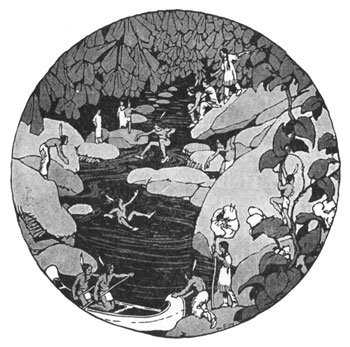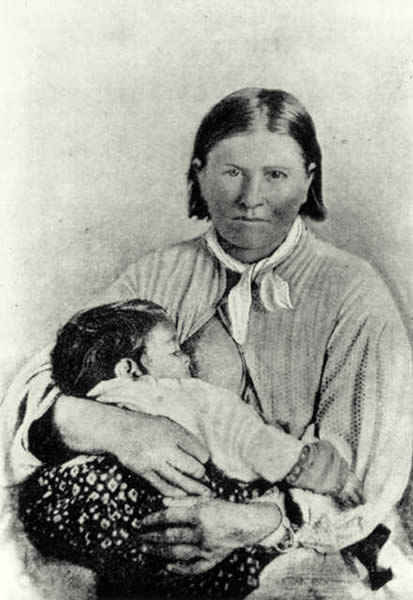|
Crow Religion
Crow religion is the indigenous religion of the Crow people, Native Americans of the Great Plains area of the United States. The Crow Deity In the Crow language the Creator has many names, such as ''Akbaatatdia'' (One Who Has Made Everything/Maker of All Things Above), ''Iichíkbaalee'' (First Doer/Maker), and ''Isáahkawuattee'' (Old Man Coyote). All names refer to a singular, omnipotent god who the Crow believe to have created the universe. This universe is believed to be made up of three worlds, the first is the physical world, thought to be the smallest of all the worlds, the second is the spirit world, and the third is where God alone lives. ... Crow creation stories ... One of many Crow creation stories for the physical world recalls that Old Man Coyote (OMC) was alone in a large ocean when he saw two male ducks floating upon its surface. In conversation with the ducks the subject turns to what lies beneath the sea. Old Man Coyote encourages one of the ducks to dive, whic ... [...More Info...] [...Related Items...] OR: [Wikipedia] [Google] [Baidu] |
Indigenous Religion
Indigenous religions is a category used in the study of religion to demarcate the religious belief systems of communities described as being "indigenous". This category is often juxtaposed against others such as the "world religions" and "new religious movements". The term is commonly applied to a range of different belief systems across the Americas, Australasia, Asia, Africa, and Northern Europe, particularly to those practiced by communities living under the impact of colonialism. The term "indigenous religions" is usually applied to the localised belief systems of small-scale societies. These belief systems do not typically engage in proselytization, thus distinguishing them from movements like Christianity, Islam, and Buddhism that all seek converts and which are typically classified as "world religions"; unlike Judaism, even though it is often referred to as a “world religion”. They are also often characterised as being distinct from the "world religions" because they ... [...More Info...] [...Related Items...] OR: [Wikipedia] [Google] [Baidu] |
Native American Church
The Native American Church (NAC), also known as Peyotism and Peyote Religion, is a Native American religion that teaches a combination of traditional Native American beliefs and Christianity, with sacramental use of the entheogen peyote. The religion originated in the Oklahoma Territory (1890–1907) in the late nineteenth century, after peyote was introduced to the southern Great Plains from Mexico. Today it is the most widespread indigenous religion among Native Americans in the United States (except Alaska Natives and Native Hawaiians), Canada (specifically First Nations in Canada, First Nations people in First Nations in Saskatchewan, Saskatchewan and First Nations in Alberta, Alberta), and Mexico, with an estimated 250,000 adherents as of the late twentieth century. History Historically, many denominations of mainstream Christianity made attempts to convert Native Americans to Christianity in the Western Hemisphere. These efforts were partially successful, for many Nat ... [...More Info...] [...Related Items...] OR: [Wikipedia] [Google] [Baidu] |
Fairies
A fairy (also fay, fae, fey, fair folk, or faerie) is a type of mythical being or legendary creature found in the folklore of multiple European cultures (including Celtic, Slavic, Germanic, English, and French folklore), a form of spirit, often described as metaphysical, supernatural, or preternatural. Myths and stories about fairies do not have a single origin, but are rather a collection of folk beliefs from disparate sources. Various folk theories about the origins of fairies include casting them as either demoted angels or demons in a Christian tradition, as deities in Pagan belief systems, as spirits of the dead, as prehistoric precursors to humans, or as spirits of nature. The label of ''fairy'' has at times applied only to specific magical creatures with human appearance, magical powers, and a penchant for trickery. At other times it has been used to describe any magical creature, such as goblins and gnomes. ''Fairy'' has at times been used as an adjective, with a m ... [...More Info...] [...Related Items...] OR: [Wikipedia] [Google] [Baidu] |
Trickster
In mythology and the study of folklore and religion, a trickster is a character in a story (god, goddess, spirit, human or anthropomorphisation) who exhibits a great degree of intellect or secret knowledge and uses it to play tricks or otherwise disobey normal rules and defy conventional behavior. Mythology Tricksters, as archetypal characters, appear in the myths of many different cultures. Lewis Hyde describes the trickster as a "boundary-crosser".Hyde, Lewis. ''Trickster Makes This World: Mischief, Myth, and Art''. New York: Farrar, Straus and Giroux, 1998. The trickster crosses and often breaks both physical and societal rules: Tricksters "violate principles of social and natural order, playfully disrupting normal life and then re-establishing it on a new basis." Often, this bending or breaking of rules takes the form of tricks or thievery. Tricksters can be cunning or foolish or both. The trickster openly questions, disrupts or mocks authority. Many cultures have tales ... [...More Info...] [...Related Items...] OR: [Wikipedia] [Google] [Baidu] |
Little People (mythology)
Little people have been part of the folklore of many cultures in human history, including Ireland, Greece, the Philippines, the Hawaiian Islands, New Zealand, Flores Island, Indonesia, and Native Americans. Native American folklore The Native peoples of North America told legends of a race of "little people" who lived in the woods near sandy hills and sometimes near rocks located along large bodies of water, such as the Great Lakes. Often described as "hairy-faced dwarfs" in stories, petroglyph illustrations show them with horns on their head and traveling in a group of 5 to 7 per canoe. Native legends often talk of the little people playing pranks on people, such as singing and then hiding when an inquisitive person searches for the music. It is often said that the little people love children and would take them away from bad or abusive parents or if the child was without parents and left in the woods to fend for themselves. Other legends say the little people if seen by ... [...More Info...] [...Related Items...] OR: [Wikipedia] [Google] [Baidu] |
Mannegishi
The Mannegishi (singular the same) are a race of trickster people in Cree folklore Folklore is shared by a particular group of people; it encompasses the traditions common to that culture, subculture or group. This includes oral traditions such as tales, legends, proverbs and jokes. They include material culture, ranging .... References Cree legendary creatures Mythological tricksters {{NorthAm-myth-stub ... [...More Info...] [...Related Items...] OR: [Wikipedia] [Google] [Baidu] |
Akbaalia
Akbaalia is a Native American mythological figure of the Plains Indians Crow Nation The Crow, whose Exonym and endonym, autonym is Apsáalooke (), also spelled Absaroka, are Native Americans in the United States, Native Americans living primarily in southern Montana. Today, the Crow people have a federally recognized tribe, th ... people. It is a healer that can cure a wide range of physical and psychological ailments. References {{Reflist Crow mythology ... [...More Info...] [...Related Items...] OR: [Wikipedia] [Google] [Baidu] |
Quanah Parker
Quanah Parker (Comanche ''kwana'', "smell, odor") ( – February 23, 1911) was a war leader of the Kwahadi ("Antelope") band of the Comanche Nation. He was likely born into the Nokoni ("Wanderers") band of Tabby-nocca and grew up among the Kwahadis, the son of Kwahadi Comanche chief Peta Nocona and Cynthia Ann Parker, an Anglo-American who had been abducted as a nine-year-old child and assimilated into the Nokoni tribe. Following the apprehension of several Kiowa chiefs in 1871, Quanah Parker emerged as a dominant figure in the Red River War, clashing repeatedly with Colonel Ranald S. Mackenzie. With European-Americans hunting American bison, the Comanches' primary sustenance, into near extinction, Quanah Parker eventually surrendered and peaceably led the Kwahadi to the reservation at Fort Sill, Oklahoma. Quanah Parker was never elected chief by his people but was appointed by the federal government as principal chief of the entire Comanche Nation. He became a primary emissa ... [...More Info...] [...Related Items...] OR: [Wikipedia] [Google] [Baidu] |
Peyote Religion
The Native American Church (NAC), also known as Peyotism and Peyote Religion, is a Native American religion that teaches a combination of traditional Native American beliefs and Christianity, with sacramental use of the entheogen peyote. The religion originated in the Oklahoma Territory (1890–1907) in the late nineteenth century, after peyote was introduced to the southern Great Plains from Mexico. Today it is the most widespread indigenous religion among Native Americans in the United States (except Alaska Natives and Native Hawaiians), Canada (specifically First Nations people in Saskatchewan and Alberta), and Mexico, with an estimated 250,000 adherents as of the late twentieth century. History Historically, many denominations of mainstream Christianity made attempts to convert Native Americans to Christianity in the Western Hemisphere. These efforts were partially successful, for many Native American tribes reflect Christian creed, including the Native American Church. ... [...More Info...] [...Related Items...] OR: [Wikipedia] [Google] [Baidu] |
Crow People
The Crow, whose autonym is Apsáalooke (), also spelled Absaroka, are Native Americans living primarily in southern Montana. Today, the Crow people have a federally recognized tribe, the Crow Tribe of Montana, with an Indian reservation located in the south-central part of the state. Crow Indians are a Plains tribe, who speak the Crow language, part of the Missouri River Valley branch of Siouan languages. Of the 14,000 enrolled tribal members, an estimated 3,000 spoke the Crow language in 2007. During the expansion into the West, the Crow Nation was allied with the United States against its neighbors and rivals, the Sioux and Cheyenne. In historical times, the Crow lived in the Yellowstone River valley, which extends from present-day Wyoming, through Montana and into North Dakota, where it joins the Missouri River. Since the 19th century, Crow people have been concentrated on their reservation established south of Billings, Montana. Today, they live in several major, mai ... [...More Info...] [...Related Items...] OR: [Wikipedia] [Google] [Baidu] |
Sweat Lodge
A sweat lodge is a low profile hut, typically dome-shaped or oblong, and made with natural materials. The structure is the ''lodge'', and the ceremony performed within the structure may be called by some cultures a purification ceremony or simply a sweat. Traditionally the structure is simple, constructed of saplings covered with blankets and sometimes animal skins. Originally, it was only used by some of the Indigenous peoples of the Americas, notably the Plains Indians, but with the rise of pan-Indianism, numerous nations that did not originally have the sweat lodge ceremony have adopted it. This has been controversial. In all cases, the sweat is intended as a spiritual ceremony – it is for prayer and healing, and the ceremony is only to be led by elders who know the associated language, songs, traditions, and safety protocols. Otherwise, the ceremony can be dangerous if performed improperly. Sweat lodges have also been imitated by some non-natives in North America and ... [...More Info...] [...Related Items...] OR: [Wikipedia] [Google] [Baidu] |
Sun Dance
The Sun Dance is a ceremony practiced by some Native Americans in the United States and Indigenous peoples in Canada, primarily those of the Plains cultures. It usually involves the community gathering together to pray for healing. Individuals make personal sacrifices on behalf of the community. After European colonization of the Americas, and with the formation of the Canadian and United States governments, both countries passed laws intended to suppress Indigenous cultures and force assimilation to majority-European culture. The Sun Dance was one of the prohibited ceremonies, as was the potlatch of the Pacific Northwest peoples.Powell, Jay; & Jensen, Vickie. (1976). ''Quileute: An Introduction to the Indians of La Push.'' Seattle: University of Washington Press. (Cited in Bright 1984). Canada lifted its prohibition against the practice of the full ceremony in 1951. In the United States, Congress passed the American Indian Religious Freedom Act (AIRFA) in 1978, which was ena ... [...More Info...] [...Related Items...] OR: [Wikipedia] [Google] [Baidu] |








